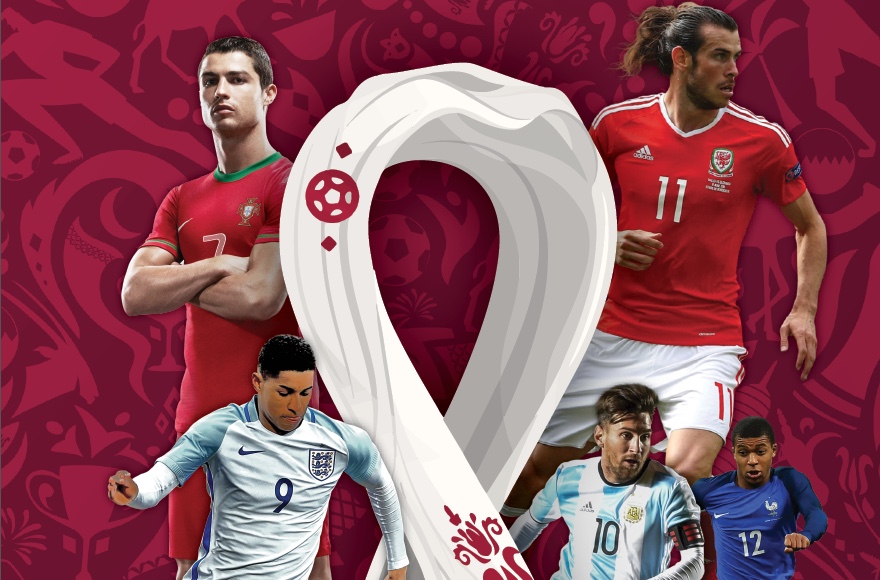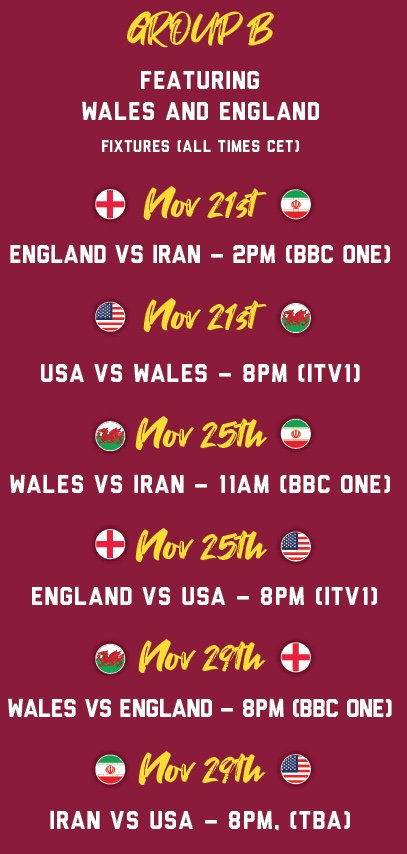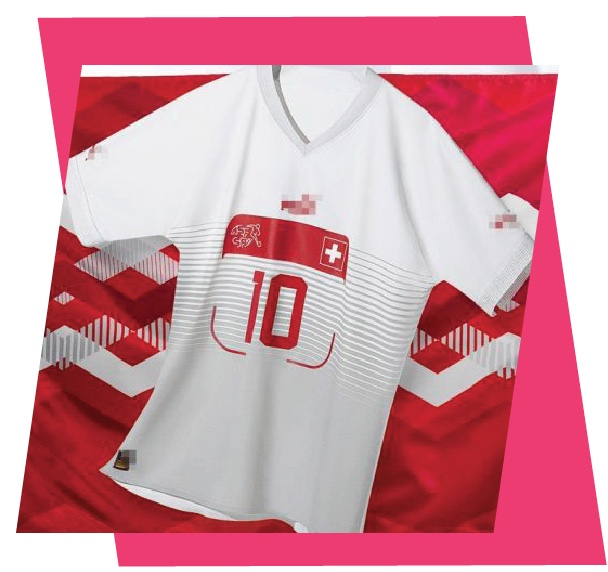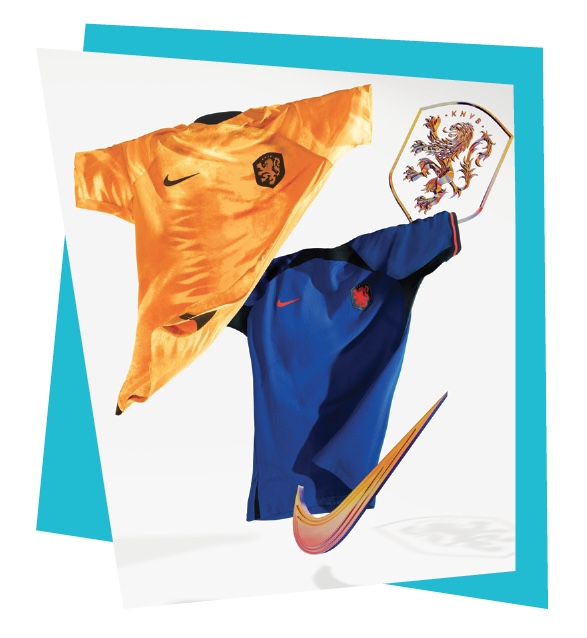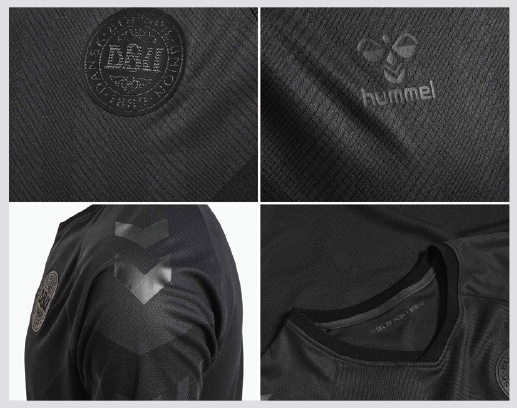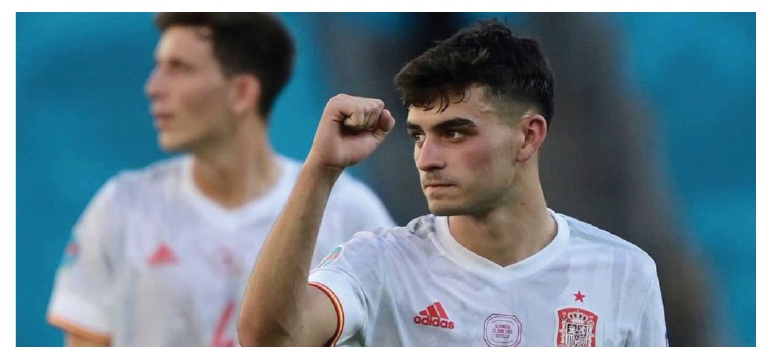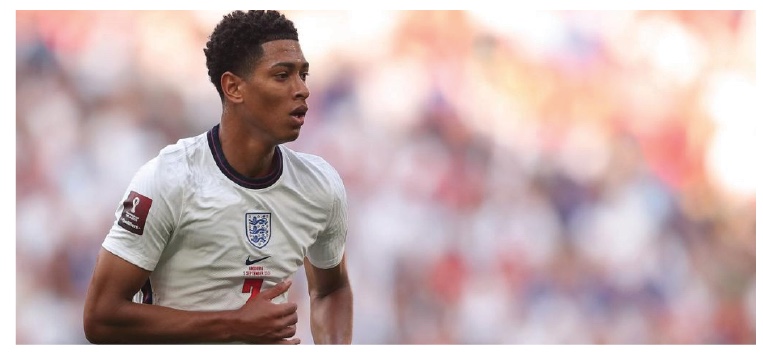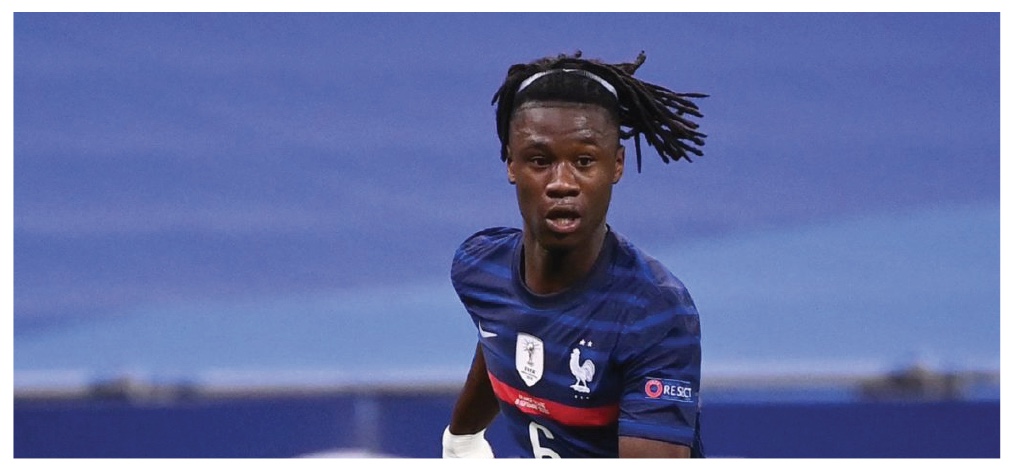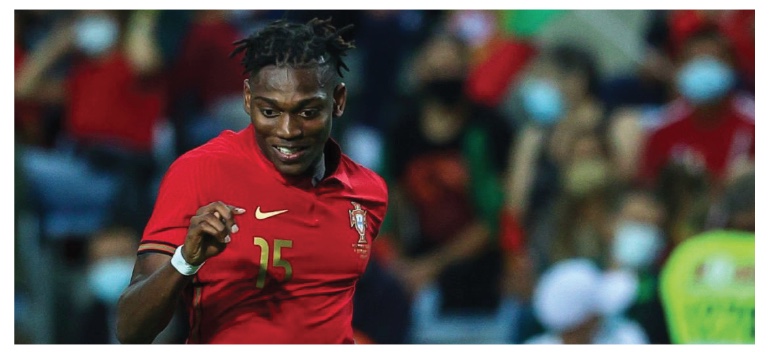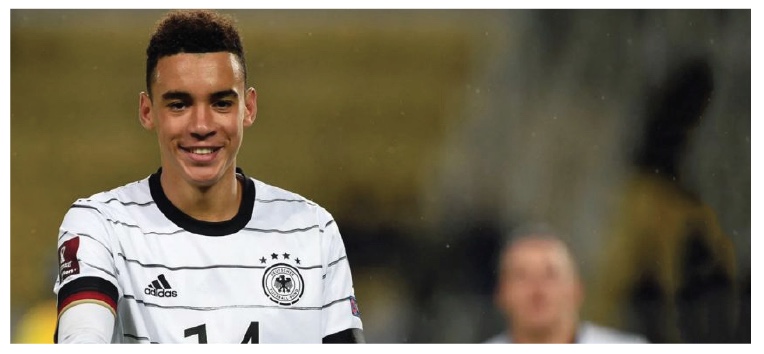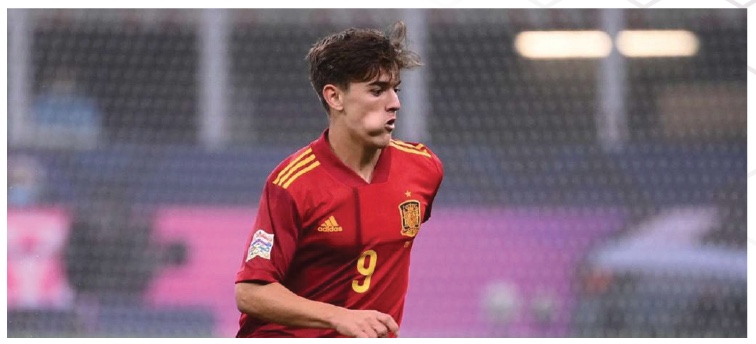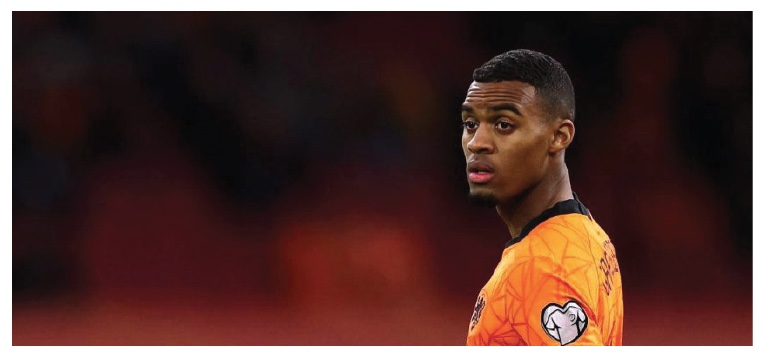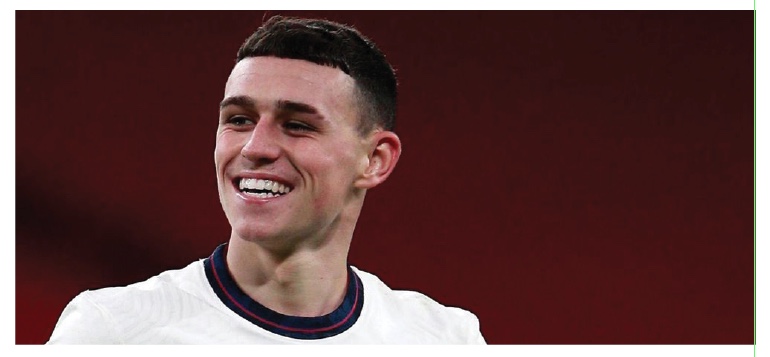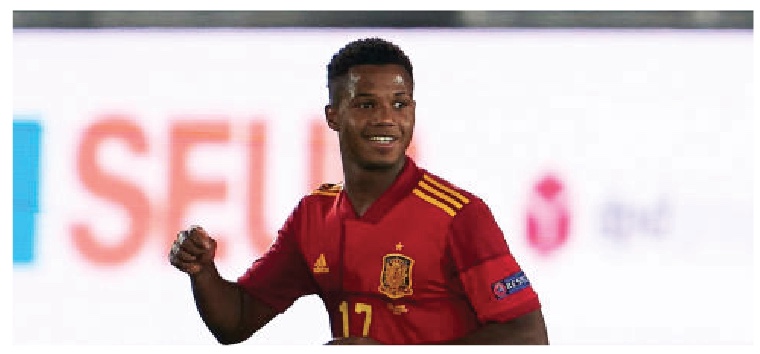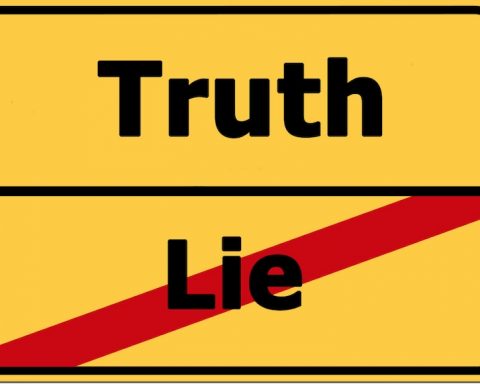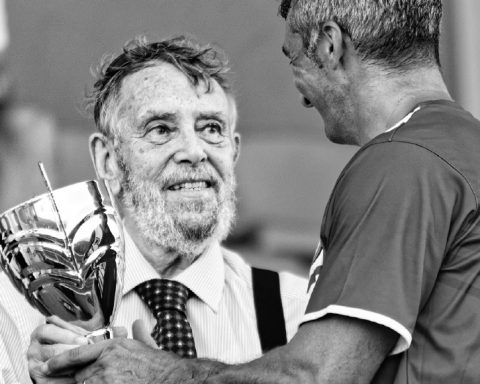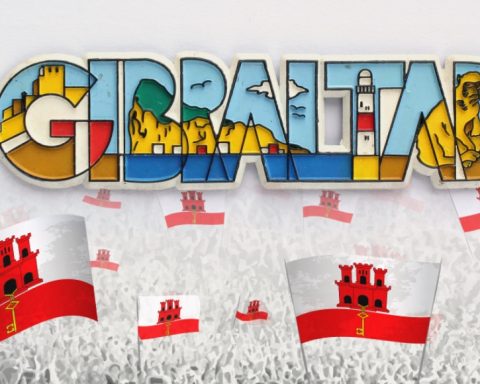High Hopes
Santa will bring home World Cup this Christmas
QATAR WORLD CUP 2022 promises to be like no previous celebration of the beautiful game – hold on to your hats, and your wives as, for the first time ever, Match of the Day clashes with the Christmas shopping, with the tournament roaring into life on Sunday 20th November and the final scheduled to take place on Sunday
18th December, a week before Santa Claus comes calling.
The potential for disruption to household harmony looms large over this festive period, with blanket TV coverage of the footy extravaganza, often covering four matches daily, all at pub-friendly hours, clashing with Jingle Bells and Slade belting out “Merry Christmas Everyone” just as mummy and daddy are queueing up in Morrison’s, Mark’s & Sparks, Emporium et al, scouring Irishtown in an attempt to lighten Santa’s load.
Women can be strange creatures, one or two I’ve known don’t even like football, indeed I’ve had first hand experience of this curious condition when working for the Guardian newspaper in London many years ago. Stuck in a small editorial room that boasted just the one telly, I was settling down to watch England vs Italy in a World Cup quarter-final when a lady, much more senior than I, pulled rank and insisted that she wanted to watch The Antiques Road Show instead!
Aghast, I hastily left the building and enjoyed the game along with quaffing several pints of cider in the Betsey Trotwood pub across the road. So, my tip to harried hubbies on how to avoid marital conflict and prevent possible blood on the carpet, is to bung the little woman an extra few quid for the prezzies and, unfettered by any feminine distractions, off to the pub with you and enjoy the game without any interruptions, amid friendly fellow footy fans.
Featuring 32 of the world’s greatest football nations, split into eight qualifying groups of four, hopes are high that the two British qualifiers, Wales and England, drawn together in Group B with two lesser lights United States and Iran, can go far in this tournament, the 22nd running of the world’s greatest sporting event. The top two teams from each of the eight groups go through to the last 16 knockout stage.
Quite how Qatar came to be chosen to host football’s most hallowed event is still shrouded in mystery – the tiny Middle East country, population less than three million, with no football tradition whatsoever and at time of event allocation with no suitable stadia, successfully saw off bids from established soccer nations, including United States, Japan and Australia.
Suffice to say, the application of cash in unimaginable amounts worked the oracle, with the identity of the recipients remaining a secret, at least for the time being, no doubt with some eminent FIFA and national football figures, a few rumour has it, hailing from quite close to home, looking nervously over their shoulders, fearful of what dark deeds may be revealed in the unlikely event that a genuine forensic investigation into Qatar’s successful bid is launched.
Adding to the puzzle is that football’s holy grail has for the first time been switched to a European winter schedule – an attempt to counter the searing 40°c summer heat of Middle Eastern sun – a remedy that has necessitated the suspension of major domestic and continental football leagues. Phew, those brown envelopes must have been very bulky indeed!
The action kicks off on Sunday 20th November when hosts Qatar take on Ecuador while domestic neighbours Wales and England join the fray a day later, when the Men from the Valleys face the United States and the Three Lions do battle with Iran. The bookies appear to have written off any chance of the Taffs lifting the cup, quoting rather insulting odds of 150/1 on that possibility, while England are priced at a very skinny-looking 7/1.
Wales ended a 64-year drought when qualifying for the finals via a 1-0 play-off victory over Ukraine and should certainly not be underestimated – star players, potent striker Gareth Bale and midfield dynamo Aaron Ramsey can cause chaos to any defence, and it will be disappointing if they fail to make the last 16. The recent addition of true great 73-cap Wales and Liverpool legend Ian Rush to the backroom staff as ambassador and advisor more than compensates for the loss of one-time manager and self-confessed sex addict, the very troubled Ryan Giggs.
England qualified for the finals with consummate ease, and were cruelly pipped on penalties by Italy in the Euros final, but the long honeymoon Gareth Southgate has enjoyed with the fans screeched to a halt with the Three Lions suffering a 4-0 Nations League trashing by Hungary at Wolverhampton – the worst home defeat since 1928. Gentleman Gareth may wow granny with his three-piece suit and sartorial elegance, but the boos that rang round Molineux on that astonishing June night mean he is now under pressure like never before.
England have the individuals talented enough to claim the crown – Raheem Sterling and Harry Kane are two world-class warriors capable of bagging bagfuls of goals but, sadly, the defence is just as adept at conceding similar amounts. So Gareth, tighten up the rearguard and with Kane and Sterling wreaking their usual havoc up front, it won’t prove to be an impossible dream, and the World Cup will be tucked snugly in Santa’s sack this Christmas!
Complete guide to Qatar tournament
The 2022 World Cup in Qatar is rapid approaching and fans around the world are getting prepared to watch every second of the biggest single sporting event in the world.
World renowned stars like Kylian Mbappe, Lionel Messi and Neymar are set to strut their stuff in the first ever World Cup to be held in the Arab world.
Here’s everything you need to know about the World Cup’s history and the upcoming tournament in the Middle East.
What is the World Cup?
Hold on, this is too easy. Everyone knows that. Yes and no. Just like boiling an egg, you may know but do you really know?
The FIFA World Cup is an international football tournament contested by men’s senior national teams of members of FIFA.
Qualifying rounds take place in the years leading up to each tournament. They are held in FIFA’s six continental zones – Africa, Asia, North and Central America and the Caribbean, South America, Oceania, and Europe – with the amount of qualifying spots given to each zone decided by FIFA.
Host nations have received automatic qualification for each World Cup finals tournament since the 1938 World Cup. Champions are still required to qualify for each tournament.
World Cup history
The international governing body FIFA was officially created in 1904 in Paris and by 1930 every affiliated country had been invited to compete in the first ever World Cup that year. It was hosted in Uruguay and subsequently had more South American sides competing than nations from Europe – only Belgium, France, Romania and Yugoslavia travelled across the sea.
The tournament grew from 13 participating teams to 16 in 1934, where Italy won in their homeland before retaining their title four years later in France.
The planned 1942 and 1946 World Cups were cancelled due to World War II but the tournament returned in 1950, where inaugural hosts Uruguay collected the most points from the final round to win the trophy.
World Cups have been played every four years ever since, with nations Brazil, England, Germany, France, Argentina and Spain all winning the competition in that time.
World Cup winners
1930 – Uruguay 4-2 Argentina
1934 – Italy 2-1 Czechoslovakia (AET)
1938 – Italy 4-2 Hungary
1950 – Uruguay 2-1 Brazil
1954 – West Germany 3-2 Hungary
1958 – Brazil 5-2 Sweden
1962 – Brazil 3-1 Czechoslovakia
1966 – England 4-2 West Germany (AET)
1970 – Brazil 4-1 Italy
1974 – West Germany 2-1 the Netherlands
1978 – Argentina 3-1 the Netherlands
1982 – Italy 3-1 West Germany
1986 – Argentina 3-2 West Germany
1990 – West Germany 1-0 Argentina
1994 – Brazil 0-0 Italy (3-2 on penalties)
1998 – France 3-0 Brazil
2002 – Brazil 2-0 Germany
2006 – Italy 1-1 France (5-3 on penalties)
2010 – Spain 1-0 the Netherlands (AET)
2014 – Germany 1-0 Argentina (AET)
2018 – France 4-2 Croatia
World Cup rules
Substitutions
12 substitutes can be named by managers for each World Cup game. An additional swap can be made when a match goes to extra time, regardless of whether a team has made their full quota of permitted subs already.
Suspensions
Players who are sent off are banned outright for one game – this applies to both straight red cards and accumulation of yellows. Two bookings in separate games result in a one-game suspension.
Yellow cards are then wiped out at the quarter-final stage.
Offside rule
This one is best explained by your mate in the pub after a couple of refreshing ales while watching a game. He’ll be right, obviously.
World Cup highest goalscorers
Miroslav Klose became the greatest goalscorer in World Cup finals history in 2014, when he overtook Ronaldo’s 15 goals to reach 16 for Germany.
The only current player in the top 15 is Thomas Muller, who has netted ten times for Germany on the biggest stage.
Miroslav Klose (Germany) – 16
Ronaldo (Brazil) – 15
Gerd Muller (West Germany) – 14
Just Fontaine (France) – 13
Pele (Brazil) – 12
Sandor Kocsis (Hungary) – 11
Jurgen Klinsmann (West Germany, Germany) – 11
Helmut Rahn (West Germany) – 10
Gary Lineker (England) – 10
Gabriel Batistuta (Argentina) – 10
Teofilo Cubillas (Peru) – 10
Thomas Muller (Germany) – 10
Grzegorz Lato (Poland) – 10
Eusebio (Portugal) – 9
Christian Vieri (Italy) – 9
World Cup Golden Ball winners
The Golden Ball award is given to the best player at a World Cup and was first awarded in 1982, when Paolo Rossi’s six goals took Italy to victory in Spain.
Legendary icons like Diego Maradona, Ronaldo and Lionel Messi have all been named the best player at a tournament, with the most recent winner being Luka Modric as Croatia reached the final in 2018.
1982 – Paolo Rossi (Italy)
1986 – Diego Maradona (Argentina)
1990 – Salvatore Schillaci (Italy)
1994 – Romario (Brazil)
1998 – Ronaldo (Brazil)
2002 – Oliver Kahn (Germany)
2006 – Zinedine Zidane (France)
2010 – Diego Forlan (Uruguay)
2014 – Lionel Messi (Argentina)
2018 – Luka Modric (Croatia)
The contenders for this year may well include Messi and Modric again, though stars like Cristiano Ronaldo, Kevin De Bruyne and Neymar will be in contention if their respective nations go deep into the tournament.
Best Young Player award
The Best Young Player award is given to the best performing young player at a World Cup tournament. It was first officially awarded in 2006, when Lukas Podolski scooped the trophy.
FIFA retrospectively named the best young players at old tournaments via an internet survey.
1958 – Pele (Brazil)
1962 – Florian Albert (Hungary)
1966 – Franz Beckenbauer (West Germany)
1970 – Teofilo Cubillas (Peru)
1974 – Wladyslaw Zmuda (Poland)
1978 – Antonio Cabrini (Italy)
1982 – Manuel Amoros (France)
1986 – Enzo Scifo (Belgium)
1990 – Robert Prosinecki (Yugoslavia)
1994 – Marc Overmars (the Netherlands)
1998 – Michael Owen (England)
2002 – Landon Donovan (USA)
2006 – Lukas Podolski (Germany)
2010 – Thomas Muller (Germany)
2014 – Paul Pogba (France)
2018 – Kylian Mbappe (France)
World Cup Golden Boot winners
The Golden Boot – previously called the Golden Shoe – is awarded to the top scorer of any given World Cup. Records show the top scorers for early World Cups, but the award wasn’t officially introduced until 1982.
If there is a tie for top scorer with the same number of goals, the tie-breaker is fewer goals scored from penalties. It is then decided on who has more assists. If there is still a tie, the tie-breaker is playing the least amount of time.
1930 – Guillermo Stabile (Argentina) – 8
1934 – Oldrich Nejedly (Czechoslovakia) – 5
1938 – Leonidas (Brazil) – 7
1950 – Ademir (Brazil) – 8
1954 – Sandor Kocsis (Hungary) – 11
1958 – Just Fontaine (France) – 13
1962 –
Florian Albert (Hungary), Valentin Ivanov (Soviet Union), Garrincha (Brazil), Vava (Brazil), Drazan Jerkovic (Yugoslavia), Leonel Sanchez (Chile) – 4
1966 – Eusebio (Portugal) – 9
1970 – Gerd Muller (West Germany) – 10
1974 – Grzegorz Lato (Poland) – 7
1978 – Mario Kempes (Argentina) – 6
1982 – Paolo Rossi (Italy) – 6
1986 – Gary Lineker (England) – 6
1990 – Salvatore Schillaci (Italy) – 6
1994 –
Oleg Salenko (Russia), Hristo Stoichkov (Bulgaria) – 6
1998 – Davor Suker (Croatia) – 6
2002 – Ronaldo (Brazil) – 8
2006 – Miroslav Klose (Germany) – 5
2010 – Thomas Muller (Germany) – 5
2014 – James Rodriguez (Colombia) – 6
2018 – Harry Kane (England) – 6
Harry Kane won the Golden Boot in Russia and will be among the favourites for the prize this winter. However, Mbappe and compatriot Karim Benzema are just two of the premier goalscorers Kane will have to fend off to be top scorer.
Dark horses include the likes of Vinicius Junior, Lautaro Martinez and Romelu Lukaku.
World Cup Golden Glove winners
The Golden Glove is awarded to the best goalkeeper at a World Cup tournament. It was initially called the Lev Yashin Award in 1994, but was later retitled in 2010. The decision is made by the FIFA Technical Study Group.
1994 – Michel Preud’homme (Belgium)
1998 – Fabien Barthez (France)
2002 – Oliver Kahn (Germany)
2006 – Gianluigi Buffon (Italy)
2010 – Iker Casillas (Spain)
2014 – Manuel Neuer (Germany)
2018 – Thibaut Courtois (Belgium)
Thibaut Courtois is the current Golden Glove holder and has arguably been the in-form goalkeeper of the last two years, enjoying great success with Real Madrid at club level. Brazil are expected to reach the late stages of the tournament, so expect Alisson to be in contention.
World Cup most finals appearances
Germany legend Lothar Matthaus has
made more appearances at men’s World Cup finals than any other player with 25.
Lothar Matthaus
(West Germany,
Germany) – 25
Miroslav Klose (Germany) – 24
Paolo Maldini (Italy) – 23
Diego Maradona (Argentina) – 21
Uwe Seeler (West Germany) – 21
Lionel Messi ought to break into the top ten this year, with the Paris Saint-Germain wizard currently sat on 19 games.
How was Qatar given the World Cup?
Oh, where to start? It all depends who you speak to and how far down that rabbit hole you want to go.
In breif, Sheikh Mohammed bin Hamad bin Khalifa Al-Thani was the chairman of Qatar’s bid committee. Their bid received an endorsement from Real Madrid and France legend Zinedine Zidane, who said “now it is time for the Middle East” to host a World Cup.
However, the compact nature of the country and the ferocious heat seemed to make the bid appear fanciful. Qatar promoted their bid as a way of bridging the Arab and Western worlds, though human rights crimes that are still prevalent today also caused a lot of criticism.
Former FIFA president Sepp Blatter then endorsed a Middle East World Cup, praising Qatar’s infrastructure and their hosting of the 2006 Asian Games.
In December 2010, it was announced the 22 executive committee members had voted to award the 2022 edition to Qatar, who had appealed to FIFA to take a “bold gamble” in bringing the World Cup to previously unchartered territory.
Local laws in Qatar
Fans travelling to Qatar have been advised to learn about the customs of the nation, with different views present on clothing, alcohol and human rights issues.
It is illegal to drink or be drunk in Qatar, though some relaxation of this law will be in force for the 2022 World Cup. Aside from expected fan zones, alcohol can only be purchased at specially licensed premises.
Why is the World Cup in November and December?
Qatar’s summer heats make a European summer World Cup impossible, as it can hit 50 degrees. Instead, the club season will break up in November and teams will travel over to the Middle East to play the tournament in a reduced timeframe.
2022 World Cup host cities & stadiums
All eight stadiums are situated in a 21-mile radius of central Doha and are powered by solar panels farms. They are also equipped with detailed cooling systems to ensure things don’t get too hot.
Lusail Iconic Stadium – Lusail
Al Bayt Stadium – Al Khor
Education City Stadium – Al Rayyan
Al Rayyan Stadium – Al Rayyan
Al Janoub Stadium – Al-Wakrah
Ras Abu Aboud Stadium – Doha
Al Thumama Stadium – Doha
Khalifa International Stadium
Where is the 2022 World Cup final?
The final is scheduled for Friday 18 December – coincidentally Qatar National Day – and will be played at Lusail Iconic Stadium, which has a capacity of 80,000.
2022 World Cup fixtures
A total of 64 games will be played throughout the tournament, beginning with Qatar vs Ecuador in the tournament’s curtain-raiser.
Among the spicier encounters in the group stage will be Argentina vs Mexico – a staple fixture at World Cups – the European clash between heavyweights Spain and Germany, and Iran vs the United States, a match with added tension due to their complex geo-political relationship.
2022 World Cup kits
Not every World Cup kit for the 2022 tournament has been released, but almost every country has confirmed at least one shirt design.
Mexico’s away kit is a thing of beauty while Ecuador have also earned some rave reviews, but Belgium’s year five disco flame shirt and Portugal’s awful split-screen top have gone down like led balloons.
2022 World Cup players to watch
Wow, where do we even start? Again we are sure your mate at the pub will have the best insight but here are our picks.
Lionel Messi and Cristiano Ronaldo may not be seen as the two outright top players in the world anymore but both likely know this may well be their final chance for World Cup glory.
France are stacked with stars like Kylian Mbappe, Antoine Griezmann and Paul Pogba, while individual stars like Son Heung-min, Gareth Bale and Sadio Mane will be hoping to lead their sides on surprise runs to the knockout stages.
2022 World Cup mascot
The mascot for the 2022 World Cup is La’eeb, a “fun and mischievous character who comes from the mascot-verse, a parallel world where all tournament mascots live,” according to FIFA.
They also say La’eeb has attended every previous World Cup tournament and has “contributed to some of the most famous moments in football history, including a number of iconic goals”.
We’re not totally convinced.
2022 World Cup ball
FIFA and adidas have confirmed the new Al Rihla ball will be used at this year’s World Cup in Qatar. ‘Al Rihla’ translates as ‘the journey’ and a strong emphasis on speed was placed on the ball’s creation.
It is also the first World Cup ball to be made exclusively with water-based inks and glues.
Facts & Stats!
The world’s most popular sporting competition pits 32 teams against each other across 64 matches for an entire month of non-stop football action. As if that’s not enough, there are many reasons why the Qatar 2022 World Cup will be unlike any other. Not to mention that it’s the first genuinely global post-pandemic football tournament.
To help prepare you for all that’s to come, here are some interesting facts about the FIFA Qatar 2022 World Cup,
The First Winter FIFA World Cup Ever
FIFA World Cup tournaments traditionally occur throughout June and July, which is summer in the Northern Hemisphere. However, as the first World Cup in the Arab world, the organisers had to make concessions due to the scorching summer temperatures in the region.
While summer temperatures peak at around 50c, winter is much more comfortable, with averages between 4c to 29c.
Costliest World Cup
With estimates ranging up to £138 billion (US$220 billion) in infrastructure investments, Qatar is the costliest World Cup to date. That’s nearly 10x more than the next most expensive World Cups, Brazil (£11.6 billion) and Russia (£14.2 billion). This is partly because Qatar is building seven brand new stadiums from scratch. It’s also nearly 64x the $3.5 billion South Africa invested in its World Cup.
Fewest Stadiums
With eight total, the Qatar 2022 World Cup will take place in the smallest number of stadiums of any previous World Cup. Seven of the eight stadiums were built entirely from scratch, while the only existing stadium was massively renovated.
The stadiums include:
• Al Bayt Stadium
•
Khalifa International Stadium
•
Al Thumama Stadium
• Ahmad Bin Ali Stadium
•
Lusail Stadium – the largest
stadium with a capacity of 80,000
• Stadium 974
• Education City Stadium
• Al Janoub Stadium
Largest Number of Potential Visitors
Situated in the Arabic Peninsula, Qatar is an established travel hub and centrally located between most major geographic regions. It’s not surprising, therefore, that the country expects to welcome the largest influx of over 1 million international spectators. It’s estimated that 1,300 incoming flights will land in the country daily throughout the competition.
First World Cup in the Middle-East
Qatar will be the first Middle-Eastern country to host the FIFA World Cup and only the second in all of Asia. The last time the FIFA World Cup visited a new region was South Africa (Africa) in 2010.
Smallest Host Country
Qatar is the smallest host country to host the FIFA World Cup by land size and population. Qatar only covers 11,571 km, making it smaller than the whole of New York City. The population is only 2.881 million. The next smallest FIFA World Cup host is Uruguay, with a land size of 176,215 km and a population of roughly 3.5 million.
Only 90 miles separate Qatar’s two stadiums that are the furthest from each other – Al Bayt and Al Wakrah. What’s more, all of the World Cup stadiums are interconnected by the Doha Metro line.
Alcohol Availability During the World Cup
As a highly conservative Muslim country, there were plenty of concerns regarding alcohol available during the World Cup. While alcohol will not be available in stadiums, Qatar has set up alcohol-friendly “fan zones” throughout the country. Alcohol sold in fan zones will also be less expensive than what’s typical for Qatar.
All Stadiums Equipped with Central Air-Conditioning
Although the Qatar 2022 World Cup takes place in winter, the host country is situated in a sub-tropical climate in one of the hottest regions in the world. Temperatures will still peak in the high 20s on most days. While December is one of the coolest months in Qatar, it’s also generally the most humid.
So, it’s no surprise that all of Qatar’s brand new stadiums will feature central air-conditioning. Each stadium will require about 115 MWh per game for cooling. That translates to roughly 43,560 household air conditioners per stadium or a whole lot of industrial fans.
South America’s Longest Streak Without a World Cup Win?
If no South American team manages to win the 2022 World Cup, it will be the continent’s longest title drought. Uruguay (1930, 1950), Brazil (1958, 1962, 1970, 1994, and 2002), and Argentina (1978, 1986) have all previously won a FIFA World Cup. The previous record was 20 years between 1950 and 1970. With Brazil having last won the World Cup in 2002, this is South America’s last chance to avoid a new record.
Nearly 12,000 Door Mats are Needed to Cover a Single Football Pitch
According to FIFA, the legal pitch dimensions for international matches is between 100m and 110m in length and 64m to 75m in width. That means you’ll require roughly 11,984 standard entrance mats to cover one regulation-size football pitch.
You Need Almost 8,000 Cans of Line Marking Spray to Mark All Qatar’s Football Pitches
Each FIFA-regulation football pitch has nearly 735.09m of lines that need marking. On the other hand, each can of line marking spray has the capacity to create 50m-90m of 50mm lines. You need 120 cans of PROline to mark all Qatar’s pitches once and 7680 cans to cover the tournament if you remark a pitch after every game!
How many bathtubs of water are needed per day to maintain the football pitches?
Due to the arid conditions, Qatar’s football pitches need more water [4] than usual to maintain. Each pitch needs about 10,000 litres of desalinated water daily to keep the grass lush and green. That’s 17,597.5 pints or 100 bathtubs (filled halfway) of desalinated water.
Most Expensive Match Tickets of Any World Cup
Unsurprisingly, considering the cost of the tournament, the 2022 FIFA World Cup will have some of the highest ticket prices ever [5]. The most expensive final tickets will cost 5,850 Qatari riyals (£1,179), up 46% from the £807 for the 2018 final in Russia. The cheapest will be available for £513.34. Group matches will start at £58.64 pounds for foreigners, while the opening match starts at £302. Qatari citizens will enjoy a discounted rate of as low as £8 for group matches.
Ranked Best Qatar Kit
1. Ecuador
Left field choice but Ecuador’s handsome navy changed comes in at #1.
Patterns can make or break a kit. Here, the subtle colors in the grey badge, along with the smooth shades of blue makes this a winner.
It’s hard to make a home shade of yellow easy on the eyes, but they’ve knocked this out of the park. The accompanying red and blue shades, plus the revamped national crest, are a sweet touch.
2. Japan
A World Cup just isn’t a World Cup without a) Japan competing, and b) Japan looking stylish.
Their 2022 home strip is one that will probably be worth about £300 in years to come. Just look at it.
3. Mexico
This kit makes me wish I was Mexican.
The beauty of national kits is you can throw so many colours and patterns together without worrying about giant sponsors ruining the shirt – adidas have utilised this creative licence to perfection. I will be ordering eight Mexico away kits immediately.
The green is back after going missing for a year so all is right with the world!
4. GERMANY
You can always rely on adidas to sort Germany out with top kit for major tournaments.
Their home kit feels a bit too Ajax/PSG meh, but the changed strip just looks like one of a team that is going to smash the World Cup final 4-0.
Ranked Worst Qatar Kit
1. BELGIUM
Belgium are threatening to bring the game into disrepute by rocking up to the biggest sporting event in the world dressed like they’re heading to a year 5 disco.
It’s not big, it’s not clever and no one is impressed.
2. SWITZERLAND
You know things are bad when a Switzerland kit isn’t a big plus.
Boom, Boom. I’m here all week.
Anyway, their changed strip for the World Cup looks like a FIFA 98 loading screen. And not in a good, nostalgic way.
3. Netherlands
Things the Netherlands home top looks like:
- Velvet
- Those cushions with reversible fur when you swipe your hand across it
- An old rug from the 1980s
Things the Netherlands away top doesn’t look like:
– A Netherlands home top
4. USA
Nice try, Nike. American fans aren’t going to be more interested in ‘soccer’ just because you made their shirt look like a NFL jersey. Looks a like a
training jersey at best.
World cup Quiz!
It’s getting close, the 2022 World Cup is now just days away.
A likely last hurrah on the World Cup stage awaits superstars Lionel Messi and Cristiano Ronaldo, while new names will break through and rising talent will be put to the test.
Many of us pride ourselves on remembering World Cup trivia from past tournaments, but just how good is your knowledge?
The First
1.
Name the English boss who at Qatar 2022 will become the first to coach a team at both the men’s and women’s World Cups?
2.
Gregg Berhalter will become the first man to serve as player and manager of the USA at the World Cup. He appeared at the 2002 tournament and is now boss of the American side. To which present-day Premier League club did Berhalter then belong, becoming their first World Cup player?
3.
Who became the first player to score a Golden Goal winner at the World Cup when he netted for France against Paraguay in a 1998 last-16 clash?
4.
In the 2018 showdown between France and Croatia, who became the first player in World Cup final history to score for both teams?
5.
Qatar will attempt to become the first nation from the AFC confederation to win their first World Cup finals match. Ten of the previous 11 have lost (including Israel in 1970), but who were the team who in 1982 managed a 1-1 draw against Czechoslovakia?
6.
There have been 52 hat-tricks in the tournament’s history, but who was the last player to score a treble in the knockout stages of the World Cup?
The Last
7.
A goalkeeper won his 159th and final international cap at the 2018 finals, when he became the oldest player to appear at the World Cup, at the age of 45 years and 161 days. He saved a penalty in a 2-1 defeat for his team against Saudi Arabia. Who was that goalkeeper and what team did he play for?
8.
Ghana reached the World Cup quarter-finals in 2010 and Senegal did so at the 2002 finals. But who were the first team from Africa to make it to the last eight, doing so at the 1990 finals in Italy?
9.
Brazil last lost a group game at the World Cup in 1998, since when they have won 12 and drawn three games at the first-round stage. Which team beat them in that 1998 tournament?
10.
Cameroon have lost each of their past seven games at the World Cup (between 2002 and 2014). Only one team have ever lost more games in a row in the competition’s history – nine between 1930 and 1958. Who were that team?
The Most
11.
Just Fontaine scored his 13 World Cup goals in just six games for France. The competition’s all-time record scorer is Germany’s Miroslav Klose, who netted 16 times for his country in how many appearances: 22, 23 or 24?
12.
Who will become the only team to have appeared at all 22 editions of the World Cup when they take part in Qatar 2022?
13.
Iran will be making their sixth appearance at the World Cup and have never gone beyond the group stage. Which country has made the most appearances (eight) without making it past the first round?
14.
Which forward had the most goal involvements of all players in European qualifiers for the 2022 World Cup, scoring 12 and assisting six times in 10 games?
15.
Since 1966, only three players have completed more than 12 dribbles in a single World Cup game, with Brazil’s Jairzinho achieving 13 against Paraguay in 1970 and Paul Gascoigne matching that total for England against Cameroon in 1990. Who managed the most – 15 in a game against Italy at the 1994 tournament?
The Goats
16.
Which superstar, who scored eight times and provided eight assists in 21 World Cup games, also holds the record for the most handball decisions given against a player at the tournament (seven) since records began?
17.
Who holds the record for the most minutes played in World Cup history, having featured in 2,216 minutes of finals action?
18.
Portugal great Cristiano Ronaldo is one of only four players to score in four different World Cup tournaments. He will attempt to go one better this year, but Ronaldo currently sits alongside Pele, Klose and which other player?
19.
Between them, Ronaldo (seven) and Lionel Messi (six) have managed 13 World Cup goals. How many of those goals came in the knockout rounds?
20.
Ronaldo is one of just two European players to have either scored and/or assisted a goal in each of the last five major international tournaments (World Cup/European Championship). Who is the other player to have managed the feat?
Denmark unveils World Cup jerseys that protest host Qatar
Black alt kits, faded logos will honour migrant workers who died during construction
Denmark will wear team jerseys at the World Cup that protest the human rights record of host nation Qatar, with a black option unveiled Wednesday to honour migrant workers who died during construction work for the tournament.
“The colour of mourning,” kit manufacturer Hummel said in a post on Instagram releasing the black third-choice design.
“While we support the Danish national team all the way, this shouldn’t be confused with support for a tournament that has cost thousands of people their lives,” the company said.
The designs seem to complete a promise made by the Danish soccer federation last November to wear clothing with “critical messages” at the tournament in Qatar.
Though FIFA’s World Cup rules prohibit political statements on team uniform, the three Denmark shirt designs in all-red, all-white and all-black appear to comply with no words or symbols that are an explicit statement. The national team badge, Hummel logo and decorative white chevrons — a famous feature of the Denmark shirt since the 1980s — are faded into the same single colour as the shirt.
“We don’t wish to be visible during [the] tournament,” Hummel said. “We support the Danish national team all the way, but that isn’t the same as supporting Qatar as a host nation.”
Denmark, the world’s No. 10-ranked team which reached the European Championship semifinals last year, has been one of the 32 World Cup teams most likely to take a strong stance against Qatar.
Top 10 young Guns to watch in Qatar
The World Cup, is coming. Teams are preparing, fans are arriving and the excitement levels are rising.
Let’s take a look at the top 10 youngsters that could shine in the 2022 FIFA World Cup.
1. Nuno Mendes
National team: Portugal
Club: PSG
It would not be surprising to see this 19-year-old left-back at the center of attention with Portugal’s national team in Qatar due to his speed and technical skills.
Being linked with a number of top sides during the summer transfer window, the former Sporting star finally joined French giants PSG and is currently continuing his improvement with Mauricio Pochettino’s side.
2. Pedri
National team: Spain
Club: Barcelona
Spain’s national team has a bright future, having a number of young talents in the squad. One of them is Pedri who sparkles both at Barcelona and at the international level.
The 19-year-old magician is considered one of the best young midfielders of his time as he has already managed to show his class in major tournaments.
3. Jude Bellingham
National team: England
Club: Borussia Dortmund
Despite his young age, Bellingham is showing quality and is proving to be fit enough to play at a senior level.
The 19-year-old Borussia Dortmund midfielder was not given much playing time during the Euro 2020. However, Qatar 2022 could become the time for him to shine as England national team player.
4. Eduardo Camavinga
National team: France
Club: Real Madrid
Joining Real Madrid during the summer transfer window, this young star had an instant impact on Carlo Ancelotti’s team, scoring his first goal just on his debut day.
The 19-year-old’s impressive La Liga displays are another stimulus for the French youngster’s involvement in international games.
5. Rafael Leo
National team: Portugal
Club: AC Milan
Leão’s meteoric rise in the last few years has played a key role in his career as he now shines at the Serie A side AC Milan.
He joined the Portgual senior national team back in October 2021. His place in the World Cup squad could be booked if we continue to see his impressive performances.
6. Jamal Musiala
National team: Germany
Club: Bayern Munich
Previously playing in Chelsea academy and later in England national team, Musiala has now moved to Germany to continue his improvement in his birthplace.
The 19-year-old became Bayern Munich’s youngest-ever player in the Bundesliga at just 17 years and 115 days old, while now he has also gained his place in the Germany senior national team.
7. Gavi
National team: Spain
Club: Barcelona
Another rising star! His few displays for the Catalan giants Barcelona were enough to impress Spain’s national boss Luis Enrique. The latter believes that Gavi is the “future and present” of their country after the 17-year-old became Spain’s youngest ever player in the Nations League win over Italy.
8. Ryan Gravenberch
National team: The Netherlands
Club: Ajax
Ajax is home to a number of talented youngsters. The Dutch team’s academy players are among the most wanted footballers in Europe, and Gravenberch is not an exception.
Various top clubs, with the likes of Barcelona, Juventus, and Manchester United, have been already reportedly linked with the 20-year-old midfielder, whose skills are promising enough to play an important role in Qatar 2022.
9. Phil Foden
National team: England
Club: Manchester City
Both Manchester City and England have found their own future star – Phil Foden.
Despite the latest struggle to enter Gareth Southgate’s first team, Foden is quite likely to be given the chance of showing his impressive skills and talent in the biggest football tournament in the world.
10. Ansu Fati
National team: Spain
Club: Barcelona
Barcelona Anfu Fati is back to the club after a long-term injury. The future is promising to be very magical for the Catalan giants’ new No 10, with the 19-year-old already showing the power of his play at the age of 18.
Fati plays for the Spain national team and there is a high probability that he will have his unique role in Luis Enrique’s plans for the World Cup.

